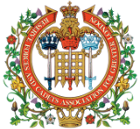London Mounted Brigade Field Ambulance
Raised by Lt Col C Stoneham CMG (Medical Officer in Middlesex Yeomanry, The Duke of Cambridge's Hussars ( 1st County of London) Yeomanry)
The Great War
Renumbered as:
8th (Mounted) Brigade Field Ambulance
4th (Cavalry) Division
Re-titled as:
11th (Cavalry) Brigade Field Ambulance
The Great War
12th Mounted Brigade Field Ambulance
2nd Cyclist Brigade Field Ambulance
4th Cyclist Brigade Field Ambulance
The Great War
1st London Clearing Hospital
To form:
56th ( 1st London) Casualty Clearing Station
1st ( 1st London) Casualty Clearing Station
WW2
4TH LONDON FIELD AMBULANCE
The Great War
4th London Field Ambulance
140 County of London Field Ambulance
140 Field Ambulance
WW2
47 (Home Counties) Field Ambulance Royal Army Medical Corps (TA)
47 (Godalming) Field Ambulance Royal Army Medical Corps (TA)
Amalgamated with:
131 (Home Counties) Field Ambulance Royal Army Medical Corps (TA)
To become:
221 (Surrey) Field Dressing Station (Volunteers) Royal Army Medical Corps
221 (Surrey) Field Ambulance Royal Army Medical Corps (TAVR)
221 (Surrey) Field Ambulance (Volunteers) Royal Army Medical Corps
217 (London) General Hospital Royal Army Medical Corps (Volunteers)
257 (Southern) General Hospital Royal Army Medical Corps (Volunteers)
To become:
256 (London) Field Hospital (Volunteers )
256 (City of London) Field Hospital (Volunteers)
5TH LONDON FIELD AMBULANCE
HQ – Woolwich Arsenal
The Great War
5th London Field Ambulance
140 County of London Field Ambulance
140 Field Ambulance
North Africa, Sicily, Italy
47 (Home Counties) Field Ambulance Royal Army Medical Corps (TA)
47 (Godalming) Field Ambulance Royal Army Medical Corps (TA)
131 (Home Counties) Field Ambulance Royal Army Medical Corps (TA)
To become:
47 (Home Counties) Field Ambulance Royal Army Medical Corps (TA)221 (Surrey) Field Dressing Station (Volunteers) Royal Army Medical Corps
221 (Surrey) Field Ambulance Royal Army Medical Corps (TAVR)
221 (Surrey) Field Ambulance (Volunteers) Royal Army Medical Corps
Amalgamated with:
217 (London) General Hospital Royal Army Medical Corps (Volunteers)
257 (Southern) General Hospital Royal Army Medical Corps (Volunteers)
To become:
256 (London) Field Hospital (Volunteers)
Re-titled as:
256 (City of London) Field Hospital (Volunteers )
6TH LONDON FIELD AMBULANCE
6th London Field Ambulance
140 County of London Field Ambulance
140 Field Ambulance
47 (Home Counties) Field Ambulance Royal Army Medical Corps (TA)
47 (Godalming) Field Ambulance Royal Army Medical Corps (TA)
131 (Home Counties) Field Ambulance Royal Army Medical Corps (TA)
To become:
47 (Home Counties) Field Ambulance Royal Army Medical Corps (TA)
221 (Surrey) Field Dressing Station (Volunteers) Royal Army Medical Corps
221 (Surrey) Field Ambulance (Volunteers) Royal Army Medical Corps
221 (Surrey) Field Ambulance (Volunteers) Royal Army Medical Corps (TA)
To become:
256 (London) Field Hospital (Volunteers)256 (City of London) Field Hospital (Volunteers)
3RD LONDON GENERAL HOSPITAL
4TH LONDON GENERAL HOSPITAL
2ND LONDON (CITY OF LONDON) SANITARY COMPANY
Notes:
- The original unit was made up of highly skilled professional with civilian occupations involved with or connected to medical and sanitary work.
- From October 1914 the unit became responsible for recruiting and training personnel to serve in all sanitary sections of the Royal Army Medical Corps serving at a scale of one section to a Division. Thus the sanitary sections served in all theatres throughout the Great War wherever there was a British Army presence.
- When in theatre all personnel of the sanitary sections wore a yellow armband on their upper left arm to indicate that the soldier was fully trained in matters of war sanitation. The Armband was originally devised by the Commanding Officer of the 1st London (City of London) Sanitary Company and approved by the War Office in 1910.
- All personnel of the sanitary sections were Territorial Soldiers.
